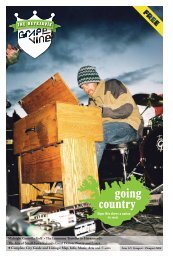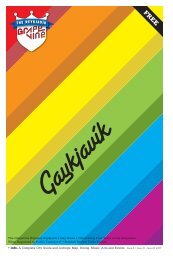7 august - The Reykjavik Grapevine
7 august - The Reykjavik Grapevine
7 august - The Reykjavik Grapevine
Create successful ePaper yourself
Turn your PDF publications into a flip-book with our unique Google optimized e-Paper software.
Outside Reykjavík<br />
Snæfellsnes<br />
Death Hikes, Berserker Lava<br />
Fields, Hag Mountains and<br />
Desolated Islands:<br />
<strong>The</strong> Under-reported Joys of<br />
Snæfellsnes<br />
Given the heat of the sun and the rate of glacial melt<br />
in today’s Arctic, we have about 2 hours to get to<br />
Snæfellsnesjökul before it completely evaporates, I tell the<br />
driver as we head out to Iceland’s most cherished peninsula<br />
in a last second decision to flee the city of Reykjavík and<br />
travel on a budget of 8000 ISK for two. We spend 4000<br />
ISK immediately, filling our car with gas, and buying<br />
bread, cheese, cappuccino yoghurt, juice and chocolate for our<br />
entire trip at Hagkaup in Kringlan on the way out of town.<br />
We have three different maps in<br />
the car, each with circles and notes<br />
from Icelanders suggesting different<br />
spots in Snæfellsnes that one should<br />
never miss: or at least, that used to<br />
be that way in the 1980s and 1990s.<br />
We have received numerous lectures<br />
on the north side versus south side<br />
(the north shore of the peninsula<br />
contains the larger picturesque<br />
fishing villages, the south shore<br />
contains the more ominous<br />
historical points.)<br />
As we leave the Reykjavík city<br />
limits on a sunny July day, the<br />
Snæfellsnes glacier seems to stay at<br />
the exact same distance, the snow<br />
glowing above the horizon like a<br />
large steel cloud. For the first few<br />
miles, I keep myself occupied with<br />
the notion that the glacier isn’t<br />
getting any bigger as we get closer.<br />
Perhaps this is because it is pouring<br />
into the ocean, causing desalination<br />
that will immediately shift the Gulf<br />
Stream, bringing about another<br />
small ice age by the end of the day.<br />
But then, coming out of<br />
Borgarnes onto Iceland’s most<br />
conventionally beautiful stretch<br />
of highway in full sunlight, I am<br />
distracted from the glacier by the<br />
local mountains and waterfalls, and<br />
by Eldborg, a massive crater that<br />
provides the kind of landscape you<br />
see photographed in New Mexico.<br />
Sunlight and good scenery clear my<br />
head of environmental concerns<br />
as quickly as healthy campaign<br />
contributions clear the heads of<br />
elected officials around the world,<br />
and suddenly I am right as rain. To<br />
further clear my head and brighten<br />
my mood, I take my friend on a<br />
death hike.<br />
<strong>The</strong> death hike is a short trek up<br />
a creek located just off of highway<br />
54 between Búðir and Arnarstapi.<br />
At a specific location, which I can’t<br />
name for reasons I’ll present later,<br />
a crevice forms in a mountainside.<br />
This crevice attracts large masses of<br />
seagulls, who seem to thoroughly<br />
enjoy the updraft against the cliff.<br />
<strong>The</strong> problem: at one point, in<br />
the back of this crevice, there is a<br />
place for the seagulls to land where<br />
there is no wind whatsoever. If the<br />
seagulls land there, they cannot fly,<br />
and they must descend a waterfall<br />
to get out of the crevice. This being<br />
against their nature, they tend to<br />
starve to death or consume each<br />
other.<br />
If you are interested, you can<br />
hike up this crevice, though it<br />
requires some advanced climbing<br />
and understanding of how to climb<br />
with the aid of a rope—which<br />
some noble sportsman has fastened<br />
so that countless many can view<br />
the slow death of seagulls. On an<br />
earlier trip, I travelled with a group<br />
of experienced hikers, including a<br />
Norwegian teenager, who had his<br />
heart completely broken by watching<br />
the seagulls in such a state. On this<br />
trip, I brought an inexperienced<br />
hiker and realized that a good deal<br />
more than your heart can get broken<br />
if you climb an eight-foot waterfall<br />
in a cave without proper precautions.<br />
As it happened, all worked out fine:<br />
my friend got to see dying seagulls<br />
and various carcasses, but she was<br />
not amused by her own near death<br />
experiences. She suggested that I<br />
not recommend the exact location<br />
to beginner hikers, unless I wanted<br />
their miserable, agonizing deaths on<br />
my hands.<br />
Following the cave of death, we<br />
drove a small 1989 Toyota sedan up<br />
the Snæfellsnes glacial road. <strong>The</strong><br />
glacier was large and icy and many<br />
people were walking around the<br />
base of it attempting to imbibe the<br />
spiritual essence of it.<br />
Imbibing the spiritual essence<br />
of the mystic Snæfellsnes glacier<br />
involves a special chant, which goes<br />
like this: “Can you walk there? Yes,<br />
I think so. But it said deep chasms.<br />
And isn’t this protected. Look,<br />
snowmobiles. Does anybody rent<br />
them? Maybe if we wait… This is<br />
really ancient.”<br />
This is really ancient is the deep<br />
moment that indicates you have<br />
found a deeper state of being or that<br />
you are ready to go back down the<br />
hill and use the toilet.










